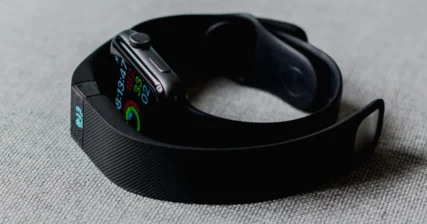Listen on: Apple Podcasts | Spotify
In almost all cases, if you exercise after getting injured, you’ll recover faster, avoid unnecessary weight gain, and maintain better well-being than if you use your injury as an excuse to become sedentary.
I’ve met many people over the years who explained they got injured years ago, stopped exercising, and gained weight, and years later, finally got sick of how they looked and felt. That should never happen.
You should workout while recovering from most injuries. There are exceptions, so check with your doctor. In most cases, if you’re able to move a limb or two, you should get back to strength training as soon as possible. Here’s why.

Feel Better Fast. Guaranteed.
Energy+, EDGE, and MentaBiotics make up the Happy Juice supplement stack, with ingredients clinically proven to:
- decrease anxiousness scores by 55%
- decrease irritability scores by 60%
- decrease fatigue by 64%
- decrease anger 54%
- decrease tension by 45%
- decrease confusion by 43%
- decrease overall distress by 49%
- increase good bacteria by 70%
- decrease negative mood by 105%
- increase positive mood by 211%
Reduce tissue lost in injured limbs
Following an injury like a bicep tendon rupture, broken bone, or severe strain, you quickly begin losing muscle. Not only does the injury itself cause muscle breakdown, the fact that you don’t use it, or the surrounding muscle, causes rapid tissue loss.
For example, a torn bicep doesn’t affect only your bicep. If you don’t use your arm, it affects your forearms’ muscles, which impact your grip strength, tricep, and the muscles in your shoulder, back, and chest on that same side.
A hamstring injury limits your use of muscles in your thighs, lower leg, hip, and low back.
The good news is, when you exercise the non-injured limb, you’ll reduce the muscle loss of the injured one.
A study published in the Scandinavian Journal of Medicine & Science in Sports adds more evidence to the benefits of exercising with an injury.
In the study, researchers divided 30 participants into three groups:
- Immobilized arm without strength training
- Immobilized arm with eccentric-only strength training
- Immobilized arm with concentric and eccentric strength training
In each case, the participants’ non-dominant arms were immobilized for four weeks.
The eccentric-only group completed 3-6 sets of 10 reps with the non-immobilized arm, using 80-120% of 1-RM. The concentric + eccentric group performed the same volume using 60-90% of 1RM.
Both types of strength training reduced muscle loss in the immobilized arm, though the eccentric-only had a more significant impact.
Other studies have come to similar findings.
Create a hormonal environment that speeds tissue regeneration
Following a weight training session, testosterone and growth hormone increase. Both hormones help to build and maintain muscle tissue.
The higher the intensity of your strength training session, the more significant effect it has on these hormones, as well. That means leg training is an essential part of injury recovery, even if you injured one of your legs.
For example, after I ruptured my Achilles’ tendon, I did many single-leg strength training sessions. In part, I wanted to take advantage of the crossover effect I covered above. But I also knew that leg training raised growth hormone and testosterone levels much more than upper body training sessions.
With one leg in a boot or cast, you can still do multiple variations of single leg squats and leg presses.
Following my distal bicep tendon rupture, I trained legs at least twice per week while also doing single arm upper body sessions.
The point is, the same hormones that help you build muscle help you speed recovery from injuries.
Maintain better blood sugar control and reduce the formation of AGEs
Elevated blood sugar leads to the formation of Advanced Glycation End products (AGEs). AGEs are combinations of sugar and proteins, lipids, or nucleic acids.
Not only do AGEs contribute to the aging of skin and development of heart disease, but they also slow wound healing and amplify scar formation. In most cases, you want to minimize scar tissue formation, or you’ll affect the function of the connective and muscle tissue as you recover.
By strength training while injured, you’ll help maintain healthier blood sugar levels and limit the formation of AGEs.
Avoid excessive body fat and inflammation
Excessive body fat increases inflammation. Excessive inflammation compromises tissue recovery.
If you’re at a healthy body fat percentage at the time of the injury, strength training will help you avoid gaining too much weight and thereby increasing inflammation levels.
If you’re already overweight, strength training and a good nutrition plan can help you get leaner while you’re injured, which may benefit the injury itself, especially if it is related to being overweight.
Maintain better mental health
Nobody likes to be injured. An injury limits your ability to do everything you usually do. It makes everyday, easy activities sometimes feel like daunting projects.
But if you stay healthy, lean, and strong while you work through your injury, you’ll feel much better.
Also, the accomplishment of completing your strength training sessions while injured should make you feel good. After all, most people use their injuries as excuses not to exercise. If you use it as a reason to exercise, you’re a leg up on others in similar circumstances.
Exercise without excuse
Pain and injuries are part of life. The only way to avoid them would be to avoid living.
So, rather than feeling sorry for yourself when you do get hurt, get back in the gym and start training right away.
Not only will you recover faster from your injury and feel better about yourself, but you’ll also inspire other people who have no injuries to up their level of commitment too.

Feel Better Fast. Guaranteed.
Energy+, EDGE, and MentaBiotics make up the Happy Juice supplement stack, with ingredients clinically proven to:
- decrease anxiousness scores by 55%
- decrease irritability scores by 60%
- decrease fatigue by 64%
- decrease anger 54%
- decrease tension by 45%
- decrease confusion by 43%
- decrease overall distress by 49%
- increase good bacteria by 70%
- decrease negative mood by 105%
- increase positive mood by 211%



